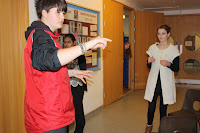SMART Targets
Target 1
Specific
When using the shot reverse shot I felt that there was a bit too much headroom at the beginning and the camera was at an angle.
Measurable
The evidence to show this is the following image:
Achievable
I feel this task is possible in the future as we could have put the camera on eye level or edited the section in between these two contrasting shots, also I feel that it would have been difficult to not put the camera on an angle due to the width of the room and the amount of space available.
Relevant/Realistic
I feel this aim will be relevant as the more headroom found in the shot, the more the audience feels out of the scene. However if the camera was at eye level, the audience will feel more involved and feel the characters emotions.
Time-Bound
This task should be done in the future whenever I complete any other future media productions and especially for the next main task of the AS media coursework.
Target 2
Specific
My next target is to use Shot, reverse shot more effectively by the camera showing the characters face when in dialogue.
Measurable
The evidence to show this follows:
At this point in the clip Kelly is speaking
Achievable
I feel this task will be achievable in the future as this fault made in the preliminary task was because as a group we didn't film enough footage and because our skills in the editing section could be improved.
Relevant/Realistic
I feel this task I have set will be relevant in the future as when the character is speaking but the camera is looking at the back of their head it makes the piece look very unprofessional and the audience slightly confused and not immediately see where the voice is coming from.
Time-Bound
I feel this task will be used throughout any other media projects to make projects look more professional and effective.
Target 3
Specific
My next target to make the project better is to add more sound effects and music.
Measurable
N/A
Achievable
I feel this task can be achieved if in next tasks we are more prepared and bring music and sound effects with us and the time scale was a bit longer, as we can then add this part in when editing
Relevant/Reliable
I feel this is relevant as this will set the mood for any future media productions and make it look more professional.
Time-Bound
I feel there is no specific timescale for this and it is a constant target.
Target 4
Specific
My next target is the lighting, as in the previous task there was a large contrast in lighting of the two settings
Measurable
Evidence is shown here:
Achievable
I feel in the next tasks this will be achievable as we will be able to use artificial light instead of relying on the natural light in the location.
Relevant/Realistic
I feel this task will be considered as realistic as we will be able to use artificial light instead of relying on the natural light in the location.
Time-Bound
I feel this task will be used throughout any other media projects to make projects look more professional and effective.
Target 5
Specific
To improve my skills on Adobe Premier Pro so that next time when I am editing, the process will be easier, therefore making it quicker.
Measurable
N/A
Achievable
I will achieve this by either asking a teacher or fellow student for help or I will practice using the software, and learn about how you insert different effects and titles.
Relevant/Realistic
I feel this task is relevant as next time when I am editing, the process will be easier, therefore making it quicker.
Time-Bound
I feel this task should be done before we start editing in the main task, then the skills that I learn can be put into practice.
































